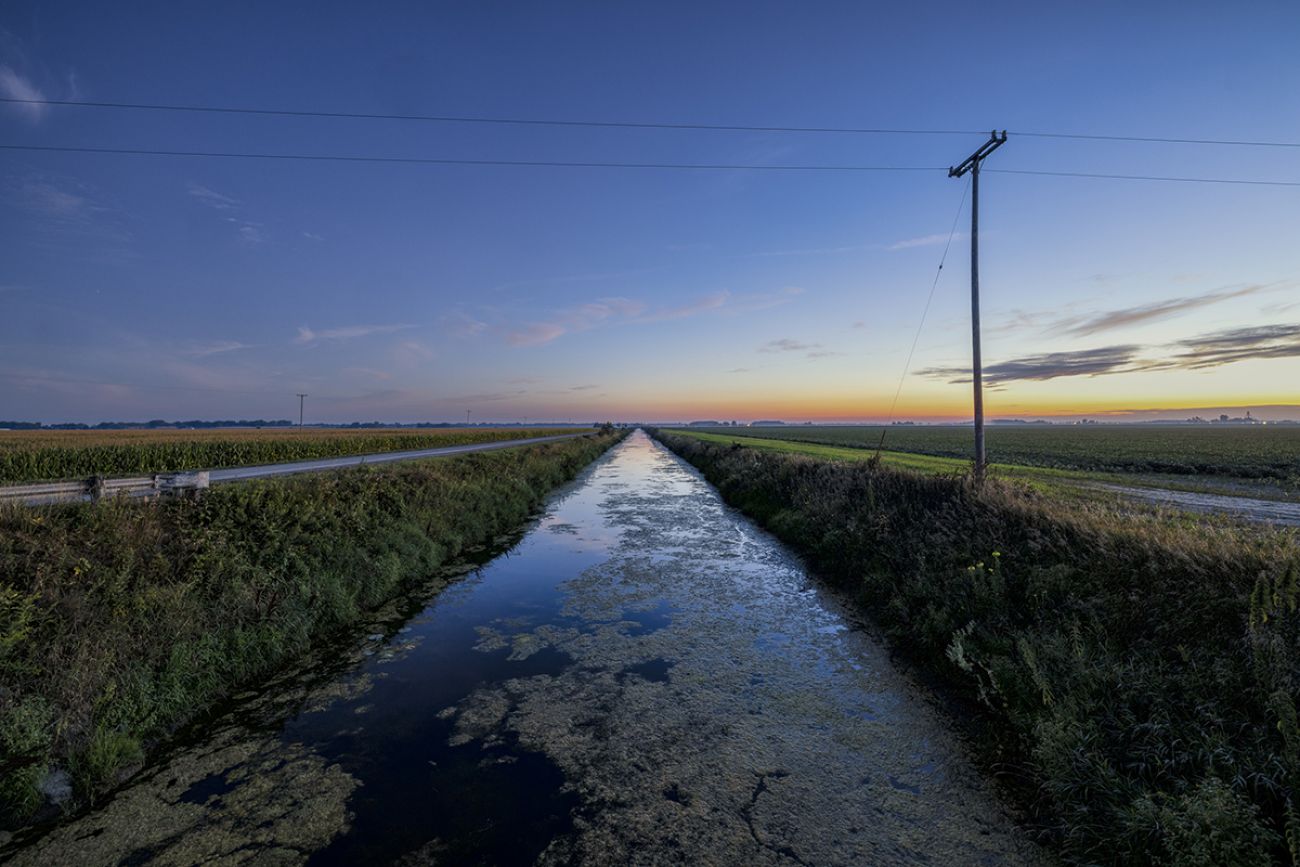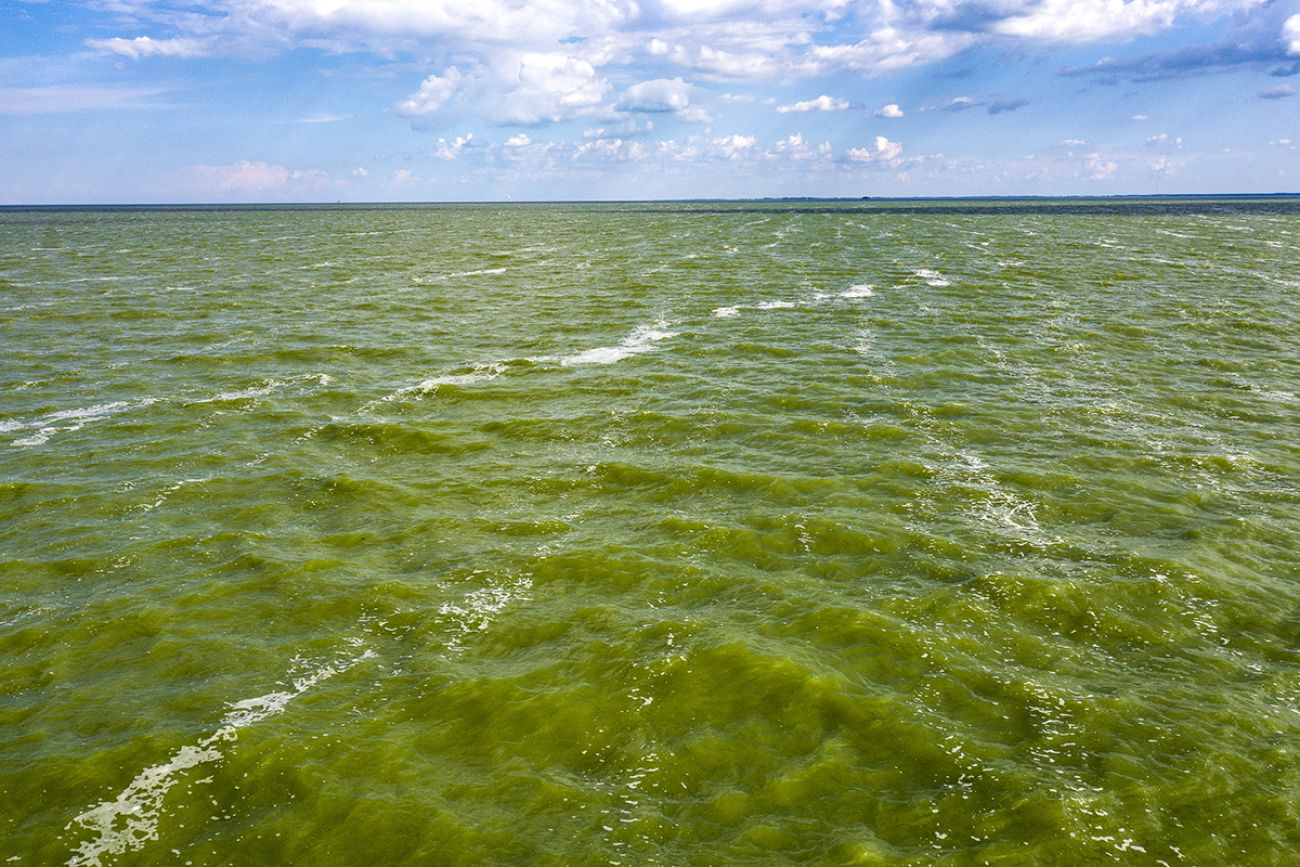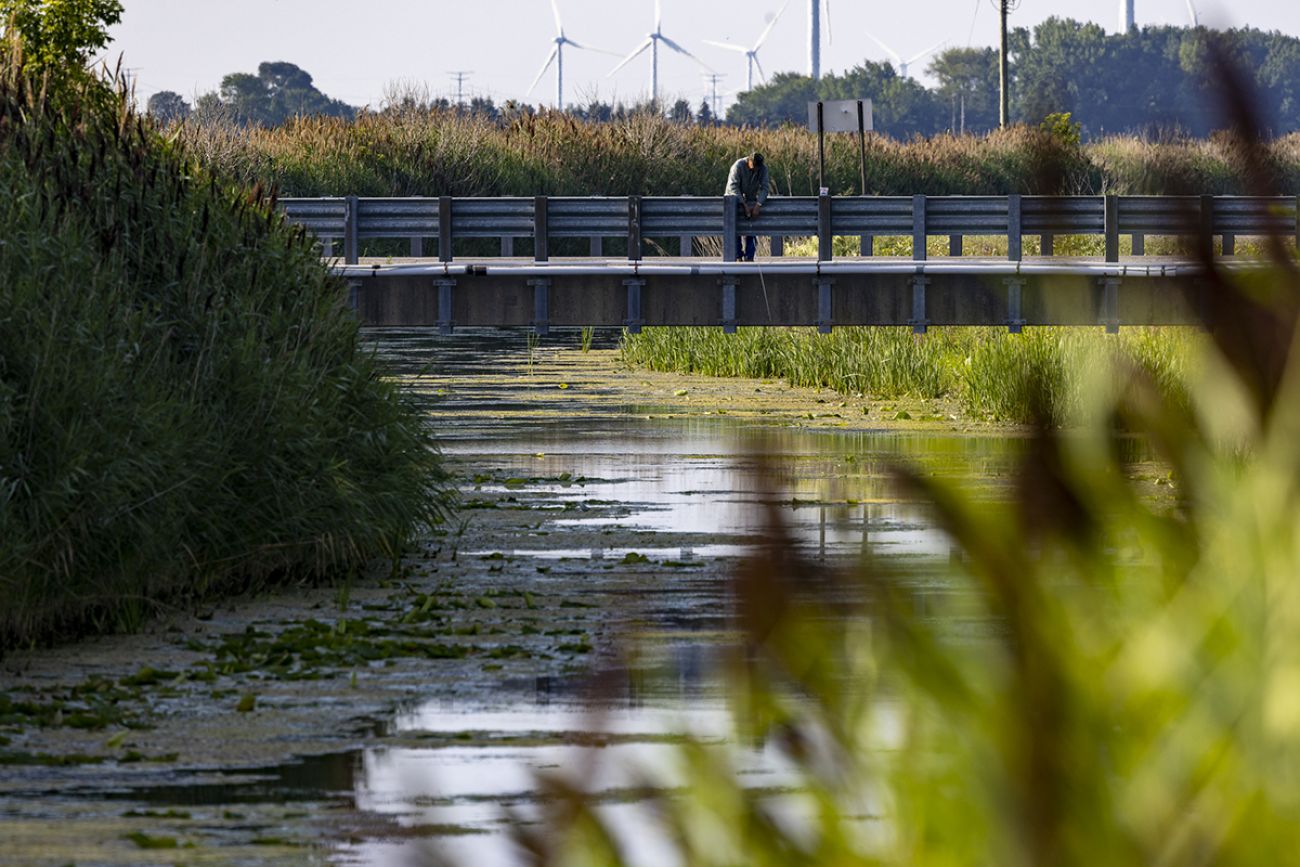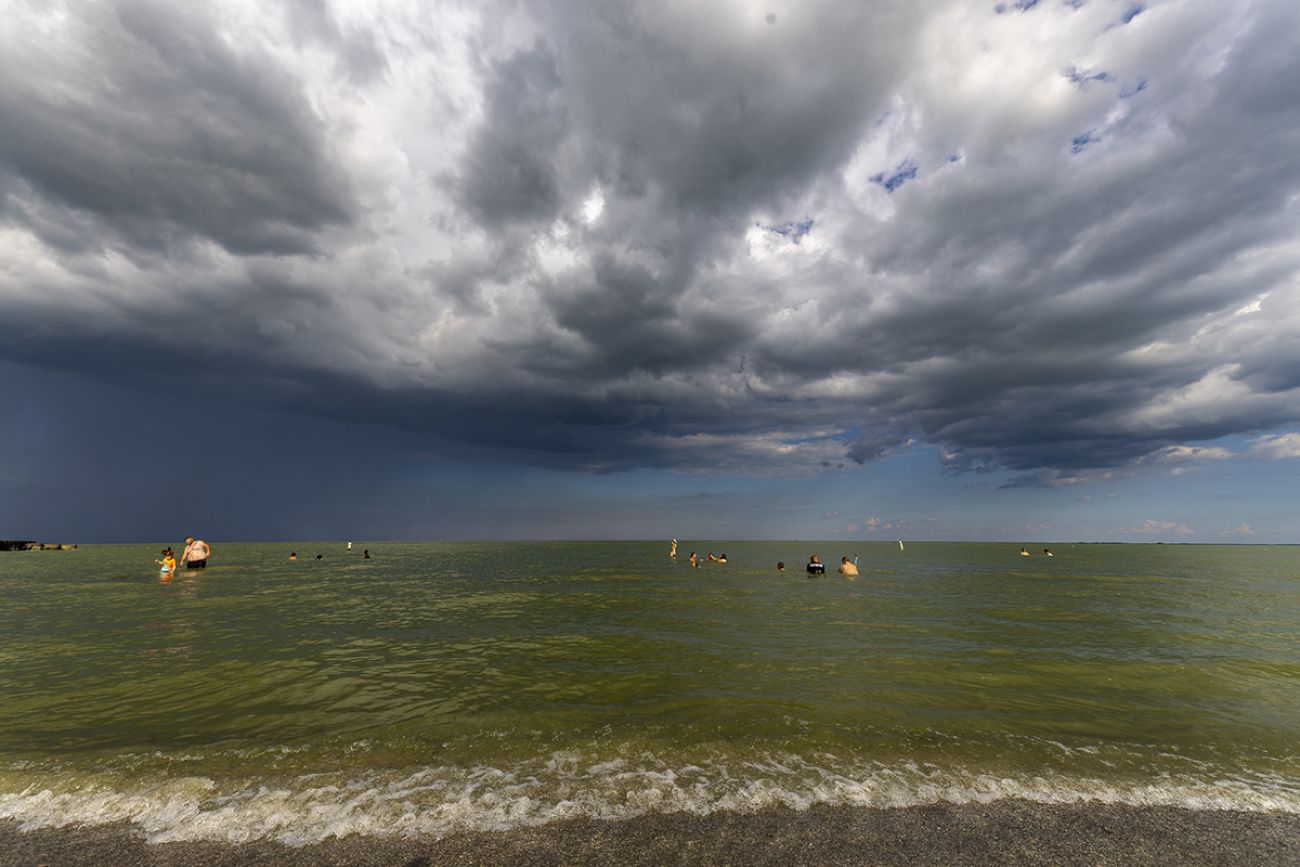Danger looms where toxic algae blooms

TOLEDO — Just as Great Lakes scientists anticipated, the first blue-green swirls of a mammoth toxic algae bloom surfaced in mid-July in the nearshore waters of Lake Erie, between Monroe, Michigan, and this Ohio port city of 275,000. Viewed from above, the sweeping curls painted an absurd, even mesmerizing portrait of harm on the surface of the shallowest and warmest of the five big lakes.
There is nothing attractive, though, about Lake Erie’s annual algal bloom, or the harmful blooms that now contaminate so many of America’s iconic waters, among them the Chesapeake Bay, Lake Okeechobee, Lake Champlain, and California’s Clear Lake. Harmful algal blooms are the biological consequence of a riptide of bloom-generating nutrients allowed by law and timid regulation to run off the land, particularly farm fields. These nutrients are the source of some of the nation’s worst water pollution.
This article is part of The Great Lakes News Collaborative, which includes Bridge Michigan, Circle of Blue, Great Lakes Now at Detroit Public Television, and Michigan Radio. It unites newsroom resources to report on the most pressing threats to the Great Lakes and drinking water supplies, including pollution, climate change, and aging infrastructure. The independent journalism is supported by the Charles Stewart Mott Foundation.
Those land-applied nutrients, especially phosphorus, largely evaded regulation in the last half-century of increasingly stringent environmental policing, despite the rising number of harmful blooms and their risk to human and animal health and recreational economies. Powerful resistance to oversight from the $1.1 trillion-a-year U.S. farm sector and surprising public tolerance have made toxic blooms a hazardous summertime mainstay of shoreline communities and lakeside residents.
Harmful algal blooms now rank with climate change as a systemic ecological threat and a severe public policy challenge. Just how much of a threat was illustrated eight years ago when a toxic bloom shut down Toledo’s drinking water supply for 500,000 people over three days. The same threat from annual toxic blooms exists for 900,000 people who rely on Michigan’s Saginaw Bay for drinking water.
Just as with climate change, local, state, provincial, and national governments in Canada and the United States have collaborated with science agencies, universities, and non-profit groups to develop effective responses, especially for Lake Erie. More than $400 million has been spent by the federal government to support water quality monitoring networks and cutting-edge science about the sources of contamination and their effects. Collaboration between governments has generated formal state, federal, and bi-national commitments to reduce nutrient discharges, and thorough action plans to achieve them.
Related:
- Join Bridge and Circle of Blue to discuss Great Lakes, algae blooms
- Reports: Huron River largely dodged hexavalent chromium scare
- Two generations and $70 million later, Muskegon Lake Is restored
What have all the spending and committee meetings wrought? After five months of investigation, and in interviews with more than 40 farmers, state regulators, advocates, and scientists in five states and Washington, D.C., Circle of Blue found that, with a few exceptions, much of it isn’t working.

Harmful algal bloom project findings
This is the first of a six-part series, “Danger Looms Where Toxic Algae Blooms,” Circle of Blue’s penetrating assessment of the causes, impediments, and solutions to harmful algal blooms that are more numerous and in many cases getting more dangerous in Michigan, Ohio, and the other Great Lakes states. Funded by the Erb Family Foundation and the Joyce Foundation, the project comes on the 50th anniversary of the Great Lakes Water Quality Agreement, a high point of environmental diplomacy, and the U.S. Clean Water Act, a pivotal piece of American environmental law. Together they were established to clear Lake Erie and other waterways of harmful algal blooms. For the first 20 years after enactment, working in tandem, the Water Quality Agreement and the Clean Water Act did just that. Lake Erie, which was famously declared ecologically dead in the 1960s, recovered.
It’s sick again. According to assessments by five federal agencies and every state in the Great Lakes basin, Lake Erie is among the country’s most visible examples of waters fouled by toxic blooms. There are many others. In 2009, the U.S. Environmental Protection Agency surveyed more than 49,000 lakes across the country and found that 30 percent contained toxins produced by the blooms. Last year, the Environmental Working Group, a Washington-based research organization, counted 476 harmful blooms in 41 states, five times higher than in 2010.
In 2019 the Centers for Disease Control and Prevention received reports of nearly 100 people sickened by toxic blooms nationwide. From 2017 to 2019, the agency counted 321 emergency department visits related to harmful algal bloom exposure
In 2018, utility directors in Salem, Oregon; Greenfield, Iowa; and Rushville, New York, issued formal advisories to residents to stop using municipal tap water because of elevated concentrations of algal toxins. The Chesapeake Bay has been the site of toxic blooms for decades.
In Florida, cyanobacteria blooms on Lake Okeechobee and red tides along the Gulf Coast are so severe that the federal Centers for Disease Control and Prevention launched a study last year to gauge the effect of inhaling algal toxins that wind and evaporation carry into the air.
In the Great Lakes region, harmful blooms are endemic. In 2019, five years after a toxic bloom shut down Toledo’s drinking water plant for three days, a harmful bloom inundated 650 miles of the Ohio River. Grand Lake St. Marys, south of Toledo, annually generates one of the worst blooms in the nation.
In Michigan the number of reports about blooms received by the state Department of Environment, Great Lakes, and Energy has increased six-fold since 2010. Saginaw Bay, Lake St. Clair near Detroit, Lake Macatawa in Holland, and Lake Allegan on the Kalamazoo River all suffer from summer blooms. Harmful blooms have even begun to appear in Lake Superior, which has the least developed shoreline of the Great Lakes.
The proliferation of toxic blooms is raising costs for residents and businesses. Monitoring and treating drinking water to block toxins and prevent human illness has become a large line item expense for water utilities. The water utility in Adrian, Michigan, spent $83,000 in 2018 on a study to decide options to deal with cyanobacteria toxins and other contaminants that threatened its water supply.
An analysis published this year by the Alliance for the Great Lakes, an environmental group, found monitoring and treatment for algal toxins cost an Ohio family of five who get drinking water from Lake Erie an extra $50 a year. For Toledo-area residents, the additional annual cost jumps to almost $100 for a family of five.

U.S. once cleared harmful blooms
Most frustrating, Circle of Blue found, is that ending toxic blooms is eminently achievable. We know that because the U.S. did it once before.
The 1972 Clean Water Act divided pollution into “point” and “nonpoint” sources. Point sources are the specific sources, like pipes, that dump contaminants to rivers, lakes, and marine shorelines. Just in the first decade following the law’s passage, Congress appropriated $36 billion ($182 million adjusted for inflation) to improve wastewater treatment plants, build new ones, and enforce the Clean Water contaminant limits. Curbing point sources, principally by limiting phosphorus discharges from wastewater treatment plants, cleared up algal blooms on Lake Erie for almost 30 years.
Blooms returned to Lake Erie and so many other bays, lakes, and streams across the Great Lakes states near the end of the last century due to pollution running off the land, which the law defined as “non-point pollution.”
The 1972 Clean Water Act essentially immunized “nonpoint” discharges from oversight. Farm runoff is unregulated under the law, and anything farmers do to slow the runoff and end nutrient discharges from their fields is voluntary. The law also set minimal requirements for storing and spreading manure and animal wastes from large livestock and poultry operations.
The waivers in the law reduced farmer costs for managing polluted runoff. That certainly helped balance sheets as U.S. farms got much bigger and more industrialized. Great Lakes farmers focused on producing milk, pork, and poultry in huge spaces where thousands of manure-producing animals are confined. Crop farmers also applied commercial fertilizer to generate immense harvests of two crops – corn and soybeans.
In order to address the ecological consequences of the legal waivers, Congress authorized programs and investments to convince farmers to voluntarily adopt conservation practices that idle farmland, plant cover crops and buffer strips, protect nutrient-absorbing wetlands, and reduce runoff. Last year, the U.S. Department of Agriculture spent $5.3 billion for those conservation programs across the country. The Environmental Protection Agency spent $212 million more on watershed management plans and other water quality initiatives. In Michigan, the total received from both agencies came to more than $55 million.
The amount of money devoted to convincing farmers to voluntarily curtail nonpoint runoff is insufficient to attract more farmers to use them. In a 2008 report, a hydrologist with the state environment department said Michigan would need to spend at least $500 million to develop new approaches to pollution prevention while also conducting the work promised in 45 watershed management plans approved and funded by the agency at the time.
Last year the Alliance for the Great Lakes published a study of what’s really needed to end algae blooms in Wisconsin’s 180,000-acre Lower Fox River watershed, which drains to Green Bay. The group said funding to diminish runoff and nutrient pollution would need to increase to $26 million annually from 2020 to 2040. That’s more than three times the $7.5 million now being spent each year.
Another study, published this year by the Institute for Agriculture and Trade Policy, a Minneapolis research group, found that half of the $1.8 billion-a-year Environmental Quality Incentives Program, the largest USDA conservation account, is aid to large animal operations — particularly dairy and hog farms. EQIP spending totaled $25.5 million in Michigan and $33.5 million in Ohio in 2020. The EQIP program is making the blooms worse, said the group.

Here are Circle of Blue’s other principal findings:
- Agriculture is the primary source of nutrient pollution to Great Lakes waters and the principal cause of the region’s harmful algal blooms.
- The number of dairy cows in Ohio and Michigan, according to the most recent US agricultural census, more than doubled to 1.6 million from 1978 to 2017. The number of hogs in both states climbed to 3.7 million, almost 700,000 more than in 1978. Cows and hogs today grow faster than they did in the 1970s, are considerably larger, and produce more manure.
- Those livestock farms, known as Concentrated Animal Feeding Operations, spread untreated animal wastes on 1.75 million acres in both states in 2017. That was 200,000 more acres than in 2002, when the USDA began tracking that data. In Michigan alone, dairy and hog farms spread 4 billion gallons of liquid manure and 400 million tons of solid manure on fields, according to the Department of Environment, Great Lakes, and Energy.
- Michigan’s work to improve its oversight of CAFOs, including a proposal to update manure spreading practices with a new permitting system, has been impeded by politically influential agricultural groups led by the Michigan Farm Bureau and supported by conservative state lawmakers.
- The expansion of nutrient-dependent corn production in Ohio and Michigan is devoted primarily to supplying two markets. Nearly 40 percent of U.S. production is converted to ethanol, a transportation fuel. Almost a third of U.S. corn exports feed China’s livestock and poultry.
“Farming has this image,” said J. David Allan, a freshwater ecologist and professor emeritus at the University of Michigan. “It’s farm to table. It’s farmers out there with their fingers in the soil. No, they’re growing pig feed. And a lot of the feed and the pigs are going to China. That’s why they’re polluting the crap out of our lakes.”

A reckoning
Our project, “Danger Looms Where Toxic Algae Blooms,” found that ending the scourge of harmful blooms requires significantly reducing the amount of phosphorus applied to the land and draining into water. That will require extensive changes in how the nation produces food, in tandem with much greater accountability by the farm sector, new regulations, and significant increases in public investment. In other words, there must be a powerful shift in America’s approach to overseeing production agriculture.
A shift of that magnitude will take years to accomplish, just as it took years for Lake Erie to recover after the passage of the 1972 Clean Water Act. Technology for controlling phosphorus is available. In several instances communities have developed alternative approaches and made progress in controlling harmful blooms. New regulations are needed to require farmers to lower nutrient applications. And more taxpayer dollars are required to help farmers pay for them.
Next year, Congress will debate and enact a new five-year Farm Bill, one of the rare spending measures that attracts bipartisan support. The legislation affords Congress two opportunities to reform conservation programs. First to support measures that pay for nutrient reducing practices that work. And second, to require farmers to use them.
In an interview Sen. Debbie Stabenow, a Michigan Democrat and chair of the Senate Committee on Agriculture, said she and her Democratic colleagues are already taking steps to address harmful blooms and support development of more effective approaches to limit phosphorus discharges. The climate bill that Congress enacted in August calls for $3.6 billion to be spent annually in each of the next five years for the most popular federal farmland conservation program. That is double the current annual budget. Another program that promotes regional cooperation and ingenuity to solve phosphorus discharges and other serious environmental challenges caused by agriculture will increase from $300 million to more than $1 billion annually.
“I totally accept that other strategies need to happen,” Sen. Stabenow said. “Let’s make them happen. We’ve got the resources now. We’ve got the flexibility.”
At this moment in our national life, solving harmful blooms may not be as much of a reach as we thought just a few months ago. Harmful algal blooms join climate crises, toxic coal ash piles, leaking gas wells, and unplugged oil wells in the basket of severe environmental challenges science has clearly identified as life-threatening, but that states and the nation seem unable or unwilling to resolve. But in approving legislation this year to rebuild infrastructure and fund significant expansion of clean energy and electrified transportation to reduce climate-changing emissions, the U.S. Congress is displaying fresh resolve to fix systemic challenges.
That once was the U.S. brand. When the United States enacted the basic foundations of environmental law, especially the 1972 Clean Water Act, voters and their elected representatives responded to scientific findings about risk.
The nation took clear steps to ensure the public interest was at least as esteemed as the private interest. Pollution-reducing rules were enacted to stem contaminants from the major industries that produced them. New agencies and well-staffed enforcement divisions stood watch. Billions were spent on new technology and equipment to ensure water got much cleaner.
Rules of engagement on environmental challenges are different in the 21st century. The balance of influence has tipped overwhelmingly to private interests. Though the causes of the country’s most serious environmental risks are well-known, and solutions are shown to work, politically powerful industrial sectors are impeding the capacity of the states and Congress to act.
The fossil fuel sector and its industrial allies block curbs to greenhouse gas emissions. The utility sector is grudgingly closing old leaking waste coal piles. The agriculture sector — the single most significant source of nutrient discharges — blocks reforms, fights lawsuits, and resists new regulation.
“There have been enough studies and academic research to know that somewhere between 88 percent and 94 percent of the problem is caused by these CAFOs, these megafarms and their nutrient nonpoint source runoff,” said Toledo Mayor Wade Kapszukiewicz, in an interview. “Everyone knows it. I’ve had the last two directors of the Ohio EPA in my office. They concede it. But they’re not politically inclined to do anything about it frankly, because those are their voters. Folks who live in cities are not their voters. They sure as hell pass the cost on to city dwellers while their rural voters have gotten by with not even a slap on the wrist.”
Michigan Gov. Gretchen Whitmer candidly expressed her frustration nearly two years ago as her administration sought to establish a more stringent set of pollution-reducing requirements for large animal farms. In a December 2020 letter to Mike Shriberg, the National Wildlife Federation’s Great Lakes regional executive director, Gov. Whitmer wrote: “Agricultural commodity groups have been unwilling to work with my administration to ensure that the state’s largest animal farms responsibly manage their manure, prevent winter runoff, and make sure pollutants are not overapplied on agricultural fields.”
The governor added: “Help is necessary from your organizations in order to make progress a reality. Please continue to use your organizations’ influence to encourage the legislature and the agricultural industry to do what is right for Michigan.”
The question is, when does the country’s tolerance for dangerous blooms begin to wane, and civic activism and legislative pressure for solutions become more intense? A number of authorities said that needs to occur quickly or they fear a calamity.
“It’s coming to the point where there’s going to be a huge public health crisis,” said Dan Moilanen, executive director of the Michigan Association of Conservation Districts, which represents 75 county offices focused on improving environmental practices in agriculture and forestry. “It’s going to result in some sort of class action suit. Like tobacco and opioids, that target the agribusiness industry. Lake Erie is the drinking water source for millions of people. The Saginaw Bay watershed is the water source for 900,000 people. There’s a lot of work that we’re doing to hopefully prevent that. The last thing we want is to have people being literally poisoned with neurotoxins.”

Lake Erie’s frustrating outlook
At the frontlines, where phosphorus drains from fields directly into streams and eventually into the Great Lakes, the contamination that feeds toxic cyanobacteria has not diminished. That leaves the 11 million people who rely on Lake Erie for drinking water anxious to learn every year just how large, and potentially dangerous, the annual summer bloom will be.
On June 30 this year a group of scientists boarded a small boat on Lake Erie, cruised across the flat waters and delivered that forecast at the Aquatic Visitors Center at Put-in-Bay. During a live online broadcast the scientists explained that the 2022 bloom would not be as large or as toxic as the biggest blooms ever recorded, which occurred in 2011 and 2015. Largely due to fewer intense rainstorms last spring, the total tons of phosphorus had dropped. A third less water had drained from the three-state, 7-million-acre western Lake Erie watershed, most of it productive farmland.
The gathered experts expressed a palpable sense of relief. “We know we have a long road ahead,” said Santina Wortman, a scientist with the Environmental Protection Agency’s Great Lakes Office. “But I do want to emphasize that our current strategy, we think, is very much on the right track. Focus on nutrient management coupled with water management.”
By almost any measure, Wortman’s assessment was the best possible interpretation of the key data points made public that day. But the hopeful projection included a prominent caveat. Concentrations of a particular form of phosphorus that feeds bloom-producing bacteria — dissolved reactive phosphorus — were still very high in streams and rivers draining into the big lake.
The signal metric scientists currently rely on to project the size of Lake Erie’s harmful algal bloom is the amount of dissolved phosphorus available to feed the cyanobacteria that cause it. Water sampling sites across the western Lake Erie basin found that concentrations of dissolved reactive phosphorus in water running off the land, particularly in watersheds dominated by big commercial farms, had not dropped at all. The waters of Ohio’s Maumee River, the most significant supplier of phosphorus to Lake Erie, were still just as contaminated with high levels of dissolved phosphorus as they’ve been for a generation. The same was true of the River Raisin and Bean Creek, which drain the six southeast counties that form Michigan’s portion of the western Lake Erie basin.
The scientists acknowledged that the 2022 harmful bloom will be smaller only because less water drained into Lake Erie this year. That meant two things. Michigan and Ohio are applying too much phosphorus fertilizer and untreated manure to farmland. And second, the voluntary best management cultivation practices intended to curb phosphorus discharges, and promoted by states and the U.S. Department of Agriculture, are not working. They also are not cheap. From 2010 to 2020, the federal government spent more than $400 million in Michigan, and the same amount in Ohio, to encourage farmers to use best practices.
Summed up: Though a bit smaller, the 2022 bloom poses risks to drinking water, to bathers, family dogs, and possibly to residents who inhale the poisonous toxins produced by the blooms.
“Unfortunately, harmful algal blooms represent a grave threat to our way of life,” said U.S. Rep. Marci Kaptur, who appeared at the Put-in-Bay event. She represents northern Ohio, and chairs the House Appropriations Subcommittee on Energy and Water Development. “Harmful algal blooms devastate abundant fish and natural wildlife and contaminate our water for the fishermen’s families, and visitors from all around who visit our special corner of the world.”
Michigan Environment Watch
Michigan Environment Watch examines how public policy, industry, and other factors interact with the state’s trove of natural resources.
- See full coverage
- Subscribe
- Share tips and questions with Bridge environment reporter Kelly House
Michigan Environment Watch is made possible by generous financial support from:
Our generous Environment Watch underwriters encourage Bridge Michigan readers to also support civic journalism by becoming Bridge members. Please consider joining today.
See what new members are saying about why they donated to Bridge Michigan:
- “In order for this information to be accurate and unbiased it must be underwritten by its readers, not by special interests.” - Larry S.
- “Not many other media sources report on the topics Bridge does.” - Susan B.
- “Your journalism is outstanding and rare these days.” - Mark S.
If you want to ensure the future of nonpartisan, nonprofit Michigan journalism, please become a member today. You, too, will be asked why you donated and maybe we'll feature your quote next time!






